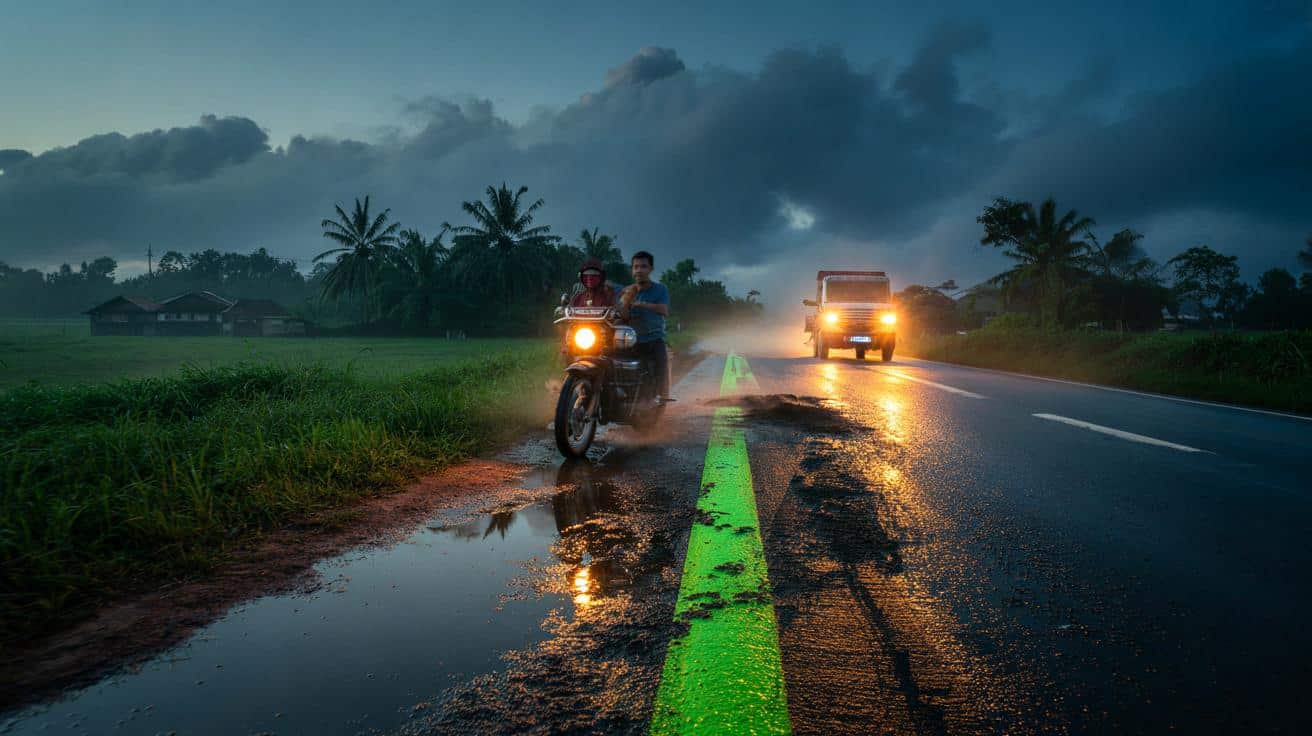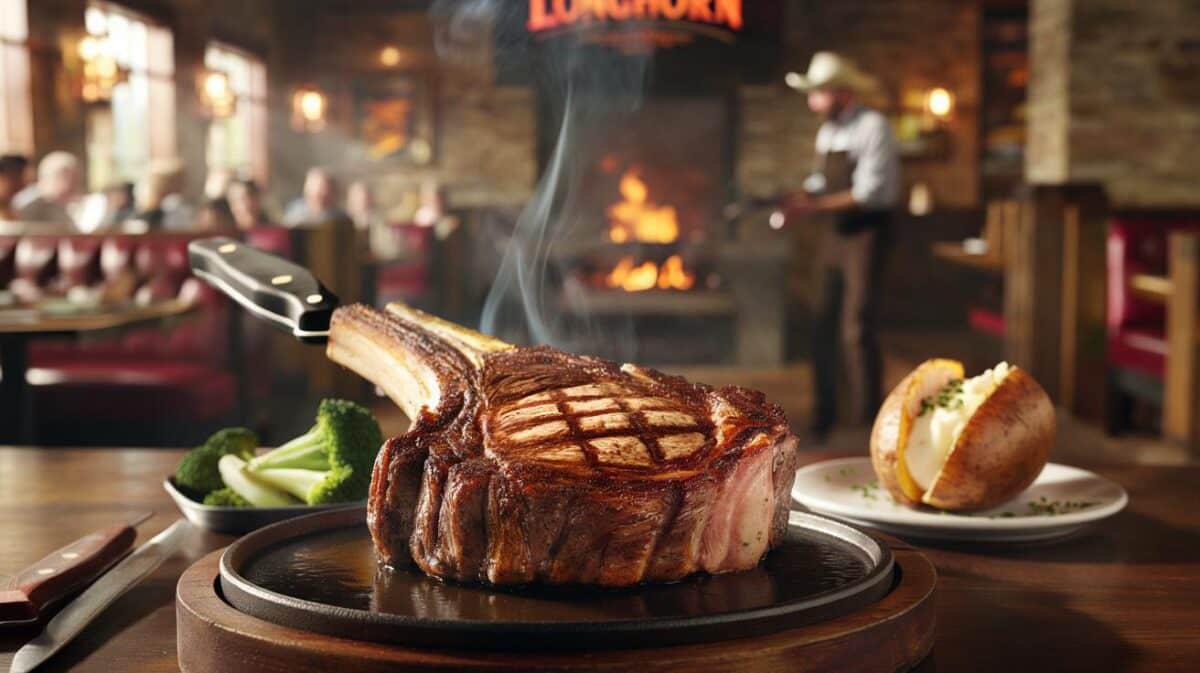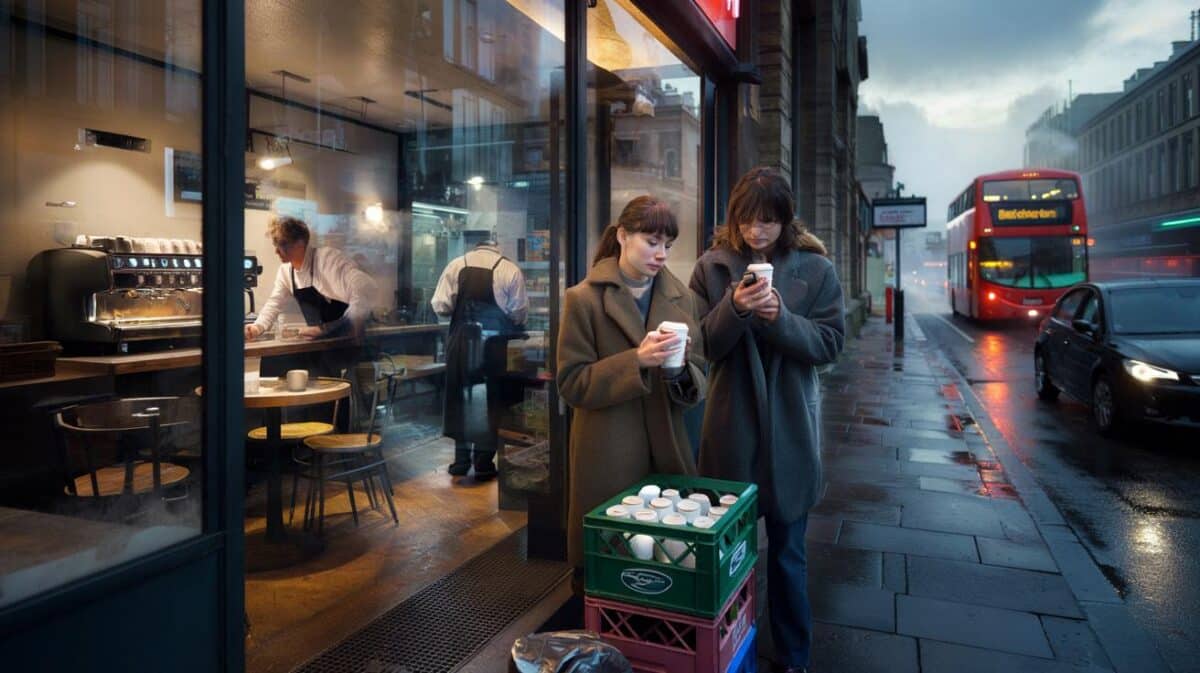Then the tropics did what the tropics do best, and a flaw lit up in plain sight.
The first time I saw the glowing line, dusk was still snagged in the palms and the road felt like a river drawn with a highlighter. A couple on a kapchai eased off the throttle, heads tilted, grinning as the paint breathed itself awake. The humidity was a warm blanket. Then clouds marched in from the Strait and swallowed the last light. A pickup sprayed a mist of grit and the line dulled, like a match going out mid-strike. Somewhere behind us, tyres hissed on slick asphalt. The air went darker than it should. Then the glow vanished.
When roads tried to shine and the night pushed back
At its heart, the concept is elegant. Photoluminescent pigments soak up daylight and release a gentle glow after sunset, turning edge lines and centre stripes into quiet guides. In a country chasing lower energy bills and safer rural journeys, the pitch writes itself. A painted line costs far less than a string of poles, and the nightscape stays dark for wildlife and stargazers. The promise felt modern, a kind of **glow-in-the-dark** common sense. People talked about it like a shortcut to safety that didn’t need a switch.
On a short pilot stretch tucked between oil palms and kampung houses, the first evenings felt almost magical. Riders pointed with their chins, drivers slowed just to look, teenagers filmed it for Instagram. The glow held, then softened as midnight leaned in. A week later, monsoon showers rolled through twice in a day. Mud stained the paint. Fine dust settled into the micro-texture that’s meant to hold pigment. A lorry wrenching onto the shoulder scuffed a metre into nothing. Locals still liked it, but the hush had gone. The line looked tired before it had earned its keep.
The science is patient and honest. Photoluminescent paints charge well in open sun and release light that fades steadily hour by hour. Under Malaysian skies, shading from canopy and cloud eats into that daytime charge. Rain pushes dirt into pores, and humidity films the surface, which cuts how much light escapes. Where headlights are strong, the glow becomes hard to notice, so the paint matters most precisely when traffic falls off. In simple terms: it shines where the night is thinnest, and struggles where the night is thick. Physics doesn’t bend for romance.
How to make a glowing road survive the tropics
If you want luminous lines to work here, start with the canvas. Choose open stretches with clear skies and good drainage, far from heavy tree canopy or frequent flood spray. Use a high-contrast base coat and a photoluminescent layer with a topcoat that resists fine grime. Pair it with retroreflective beads so it still pops in headlights. Keep junctions and sharp curves under conventional lights, and use the glow on approaches and long, straight runs. Treat the system like a living thing: a maintenance cycle, soft brushing, quick repaint spots. Small beats grand every single time.
Most failures begin with ambition trying to sprint. Rollouts jump from pilot to district without the boring bits—cleaning schedules, shoulder repair, drainage fixes. Then the glow fades and people shrug. Micro-mapping matters: a bridge deck might charge poorly, a bend under tall bamboo might never get a full day’s sun. Plan for shade and grit as real enemies, not footnotes. Let’s be honest: nobody really reads a maintenance manual at 2 a.m. Give crews a simple routine on a simple chart. Keep laughably clear handover photos. Your future self will thank you.
Think of users, not just the line. Motorcyclists ride the edge; older drivers track the centre. Test with both at 30, 60 and 80 km/h on dry and wet nights and at new moon. Then write down what you’ll tolerate. A faint line can be worse than none if it teases the eye in rain or fog.
“The paint is not a miracle. It’s a helper. Treat it like a helper and it will help.”
- Best fits: rural connectors, long causeways, scenic loops with low junction density.
- Risk zones: shaded valleys, heavy-silt shoulders, near markets where trucks mount verges.
- Plan items: weekly light clean in rainy months, monthly luminance check, quick-hit patch pot.
The bigger picture: safety, energy and the fragile night
There’s a reason this idea caught fire online. A lit road without lights tickles something inside us—clever, green, a little bit sci‑fi. Then the messy world taps our shoulder. Dirt doesn’t read policy. Rain doesn’t care about an innovation sprint. Fireflies along mangrove rivers don’t vote, but their darkness is part of the national story, and any new glow belongs in that conversation too. We’ve all known that moment when the road ahead feels thinner than our courage, and a steady line gives the fear a place to sit. *That’s the quiet promise here, and it’s worth protecting.* The trick is to blend engineering with humility, and roll carefully where nature still owns the night.
| Point clé | Détail | Intérêt pour le lecteur |
|---|---|---|
| Target the right roads | Open sky, simple geometry, low junction density | Shows where glow paint genuinely helps, not just looks good |
| Design for dirt and rain | Topcoat, drainage, light cleaning routine | Turns an online buzz into durable, **quiet safety** |
| Don’t replace lights where they carry lives | Keep conventional lighting at junctions, schools, crossings | Keeps families safe when the glow can’t carry the load |
FAQ :
- Does glowing road paint replace street lights?Not in busy or complex areas. It can complement lighting on simpler stretches, but junctions and high-conflict spots still need conventional lights.
- How long does the glow actually last at night?It’s strongest in the first hours after sunset and then softens. Cloudy days, shade and grime can shorten usable glow time.
- Will it work during monsoon season?It can, with careful design and maintenance. Heavy rain and mud film reduce perceived brightness, so cleaning and drainage are crucial.
- Is the paint eco-friendly?Photoluminescent pigments don’t need electricity, which is a plus. Any rollout should check local habitats—especially where night‑active wildlife thrives.
- Why did some pilot stretches fade so fast?Common culprits: shaded charging, dirt trapped in the surface, trucks scuffing the edges, and no regular cleaning plan.









Love the sci‑fi vibe, but the physics bit hit hard—glow where the night is thin, struggle where it’s thick. Any data on luminance decay after, say, 4 hours in cloudy conditions?
So… after the first rain and a few dusty lorries, the line goes from magic to meh? Feels like we’re underestimating maintenance cost, espeically in monsoon months.